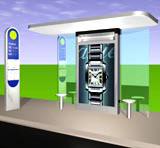Hanover bus shelter design: James Irvine
‘I was commissioned by Ströer Out of Home Media to design the shelters in August 2000 as part of its offer to the city of Hanover, to give a stronger identity to the specific furniture for the city,’ explains industrial designer James Irvine.

‘I was commissioned by Ströer Out of Home Media to design the shelters in August 2000 as part of its offer to the city of Hanover, to give a stronger identity to the specific furniture for the city,’ explains industrial designer James Irvine. ‘Ströer had the smart idea that maybe the city would like the shelters to be designed by the same person who designed the bus.’
An aluminium frame with composite materials and subtle colour referencing that gels with his bus design launched in 1999, Irvine is aware of how many cities assert identity. ‘Within a country like Germany, most cities have a corporate colour, which is a very 1970s concept of making you aware of which city you were in. For example, Berlin’s buses are yellow, and in Hanover, the buses used to be green. The early concept was that everything to do with the city would be painted green.’ Irvine does not allow this to take over his design. The project is currently out to tender for construction of around 600 shelters of different types, ‘from the most basic version to a more complex one for tram stations’, he says.
Ströer’s success in its choice of designers can also be seen in its Industry Forum Product Design Award-winning scheme of street furniture by Jasper Morrison. Like Irvine, Morrison had designed for German city councils, most recently with the Hanover link-tram design for Ãœstra. Presented at Berlin’s Public Design Fair in February, the Ströer scheme consists of waiting hall and city toilet, as well as fully glazed advertising media with backup lighting, which include the Mega Light, the City Light Showcase and the City Light Pillar.
Ströer clearly sees the advantages of quality design, ‘We offer the inhabitants and visitors to a city a piece of living quality in addition to a maximum in utilisation,’ say Udo Müller, chairman of the managing board of Ströer.
From the other side, Morrison comments, ‘I’ve always been fascinated by the difference of character and identity of towns and cities. I’ve noticed that while much importance is attached to the architecture of buildings, very little attention is paid to the urban architecture. I believe that in Europe at least that imbalance is set to change and that in the next decade we will see a re-evaluation of the urban landscape and, perhaps, a better understanding of the importance of how it is treated. In this respect the issue is the balance of the design with prospective urban landscapes, the quality of materials employed and an identity which doesn’t compete with the city’s existing identity, but which adds to it.’
-
Post a comment




